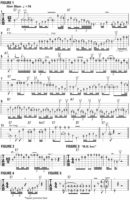
Incorporating the Major Third Across Multiple Octaves in a Blues-Based Solo
Last month we explored the concept of interjecting the major third into solo lines based primarily on the minor pentatonic and blues scales. This results in a chromatic row, from the minor third up to the fifth, which offers tremendous room for melodic experimentation.
In this lesson, we’ll explore that approach further and expand it across multiple octaves. In the key of E, the scale most often used for blues-rock-based soloing is the E blues scale (E G A Bb B D), which is intervallically spelled 1 b3 4 b5 5 b7.
The major third of E is G#, which is two whole steps above the E root. Adding the major third like this results in the note series E G G# A Bb B D, (intervallically spelled 1 b3 3 4 b5 5 b7), with a chromatic row between the minor, or “flatted,” third, G, and the fifth, B: G G# A Bb B.
FIGURE 1 is a 12-bar solo played over a slow blues groove in the key of E. For instructional purposes, I remain in fourth/fifth position for virtually the entire solo. Restricting oneself to a single position like this across an entire 12-bar solo forces the player to make the most of what’s available under your fingers on each string. I begin the solo with a reference to the major third by bending the minor third, G, up one half step to G#.
Keep in mind that G# is a chord tone for the one chord, E7, which is built from the notes E, G#, B and D. Bends like these work well to emulate the human voice, which is a key element in expressive blues guitar soloing. As you play through these initial licks, you’ll find some tricky rhythmic phrasings, so play through each beat, or each eighth note in the eighth-note triplet, to be sure you’re playing the phrases correctly.
In bar 2 into bar 3, I emphasize the flatted fifth, Bb, repeatedly moving from Bb to B through the phrase. In bar 5, over the four chord, A7, I include F#, the second, as a passing tone between G and E.
The phrases played through these bars encompass what’s known as the “B.B. box,” named after blues guitar great B.B. King. Bar 7 includes a brief move up to eighth position, with the major third sounded via a bend one octave higher than our starting pitch. I then use the B.B. box as a means to move back down to fourth/fifth position. FIGURES 2 and 3 offer a more concise look at the B.B. box combined with the E blues scale.
FIGURE 4 details the b5-to-5 idea (Bb to B), and FIGURE 5 demonstrates an effective method for combining this chromatic movement with that of the minor third to the major third (G to G#), resulting in sliding sixth intervals.
Source: www.guitarworld.com












